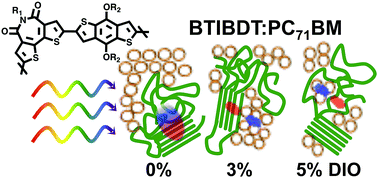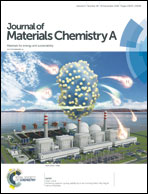Effects of 1,8-diiodooctane on domain nanostructure and charge separation dynamics in PC71BM-based bulk heterojunction solar cells†
Abstract
Processing additives are commonly used to optimize phase separation morphology and power conversion efficiency (PCE) in the bulk heterojunction (BHJ) organic photovoltaics (OPVs), however their exact effects are not well understood. A bulk-heterojunction OPV system containing the model bithiophene imide-benzodithiophene copolymer (PBTIBDT):phenyl-C71-butyric-acid-methyl ester (PC71BM) exhibits a maximum PCE of 5.4% with addition of 3.0 vol% 1,8-diiodooctane (DIO). Here the effects of increasing DIO concentrations (0 → 5 vol%) on the PBTIBDT:PC71BM solutions and resulting thin films are studied by X-ray scattering methodologies and transient optical absorption spectroscopy with 0.1 ps time resolution. As the DIO concentration increases, the radius of gyration of the PC71BM aggregates falls from 17 Å to 9 Å in solution, and TEM indicates the formation of increasing PC71BM charge percolation pathways in the thin BHJ films. Increased PBTIBDT + PC71BM intermixing not only affects BHJ film charge transport, but also enhances the initial exciton splitting yield in the PBTIBDT cation population. In contrast, the hole carrier population (as represented by the polymer cation) detected several nanoseconds after the photoexcitation is greatest with 3.0 vol% DIO, agreeing well with the corresponding BHJ composition for maximum OPV short circuit current density (Jsc) and fill factor (FF). The increase in initial polymer cation yield with DIO concentration is attributed to enhanced donor–acceptor interfacial area while the increase in long-lived cation population is attributed to formation of a bicontinuous donor polymer–PC71BM acceptor network that promotes large spatial separation of free charges in the device active layer. These results demonstrate the importance of OPV function for the correct balance, as tuned by processing additives, between a high initial donor cation formation yield and high carrier transport efficiency with minimized charge recombination rate.



 Please wait while we load your content...
Please wait while we load your content...